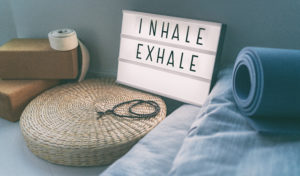
You’ve probably heard about using breathing techniques for stress relief, but do you know they’re beneficial? When you’re feeling stressed, your body responds to that stress in preparation for the danger it perceives ahead. While this bodily response, often called “fight or flight,” is necessary in truly dangerous situations, it can also be stoked by smaller, repeated stresses and worries that occur in your daily life. Over time, these stresses build up and that same response can occur.
Unfortunately, this type of ongoing stress is bad for your overall health. It can impact everything from your blood pressure and heart health to your immune system and beyond. You might even be surprised to learn that stress can cause oral health problems. From the impact of nose vs. mouth breathing, to understanding how stress causes jaw clenching, or how snoring affects your oral health, you’ll soon discover that it’s all connected.
As such, finding ways to reduce your stress is essential for the health of your entire body. Using a breathing exercise in times of stress can help relax your body, reducing the impact of stress and helping you maintain better overall health.
Breathing Exercise Eases Stress and Improves Wellness
Ever told yourself to take a deep breath when things get tense? There’s a reason for that. Deep breathing helps ensure full oxygen exchange can take place in your lungs.
When you exhale carbon dioxide-rich air and fill your lungs completely with oxygen, this sends a signal to your brain that you’re relaxed, even if you don’t feel that way yet. Nose breathing exercises also help to slow your heartbeat, stabilize your blood pressure, and slow any rapid breathing patterns.
Think of it like faking it until you make it. If you can mimic the way you breathe when you’re calm, you can trick your body into believing that you are. Once you learn how to use your breathing correctly, you can use them regularly to help manage stress and anxiety and improve your overall wellness.
Breathing Techniques to Try
To learn the benefits of inhale and exhale exercise techniques, it’s helpful to start by practicing a simple deep breathing technique to teach yourself how to fill your lungs properly and completely, rather than taking shallow breaths.
Belly breathing
Also called diaphragmatic breathing, belly breathing is a deep breathing exercise that helps you learn to use your diaphragm correctly. Belly breathing is best practiced at first when you’re already relaxed because it can be tiring until you get the hang of it.
- Start by lying flat on the ground, knees slightly bent or supported by a pillow.
- Place one hand on your belly and one on your chest.
- Take a deep breath in through your nose, working to fill your lungs completely. You should see the hand on your belly rise, but not the hand on your chest.
- Breathe out through pursed lips, as though blowing out a candle, while tightening your abdominal muscles.
If you primarily feel your chest or shoulders moving when you breathe, you’re not allowing your lower lungs to fully expand. Work on moving only your belly. Practice this 3-10 times daily before moving on to the exercises below.
4-7-8 breathing
Using similar breathing techniques to belly breathing, this exercise can be done seated or lying down to help you relax. Use 4-7-8 breathing to lower blood pressure and calm your body.
- Put one hand on your chest and one hand on your belly.
- Inhale deeply and slowly into your belly for a count of 4.
- Hold that breath for a count of 7.
- Exhale, emptying your lungs completely for a count of 8.
- Repeat these steps 3-7 times until you feel relaxed and calm.
Coherent breathing
Coherent breathing, also called resonant breathing, is a technique that reduces stress, improves heart rate, and has been shown to reduce symptoms of depression when combined with Iyengar yoga.
- Inhale for a count of 5.
- Exhale for a count of 5.
- Repeat for several minutes until you feel calm.
Breath focus breathing technique

This technique combines deep breathing with relaxing imagery or words to guide focus. Choose an image or phrase that helps you feel calm, happy, neutral, or relaxed.
- Sit or lie down comfortably.
- Notice how you’re breathing naturally without making any changes yet.
- Alternate between normal breathing and deep breathing a few times, noticing the differences in the way your belly moves. Pay attention to how shallow your normal breathing may have been.
- Work on deep breathing for a few minutes, noticing how your belly rises and falls, and sighing during the exhale.
- Inhale and focus on your chosen phrase or image to help foster calm feelings. Imagine that relaxation entering your body with the air.
- As you exhale, imagine all of your anxiety, stress, and tension leaving your body. At first, you can work on this deep breathing technique for 10 minutes at a time, eventually building up to a 20-minute practice that can be used to ease stress.
Pursed lip breathing
Pursed lip breathing is one of the more common nose breathing exercises used to help improve your ventilation. This technique helps you to keep your airways open longer, releases air that gets trapped in your lungs, and slows your breathing rate for a relaxing effect.
- Relax your shoulders and neck muscles.
- Inhale slowly through your nose for a count of 2, keeping your mouth closed. This should be a normal breath rather than an attempt at a deep breath.
- Purse your lips as though blowing out a candle.
- Exhale gently through pursed lips for a count of 4.
- Continue breathing slowly and easily until you feel calm and in control.
Lion’s breath
A lion’s breath is a stimulating breath technique used to release stress, relax your face, jaw, and throat, and possibly even improve respiratory function.
- Kneel with your back straight and torso upright and leaning forward slightly. You can also sit upright in a chair or with legs crisscrossed.
- Place your hands on your knees with your fingers spread wide, keeping your arms straight.
- Inhale deeply through your nose with your mouth closed.
- Open your mouth wide and stick out your tongue, pointing it down toward your chin.
- Exhale forcefully through your mouth with your tongue still out, making a “ha” sound as you exhale.
- Repeat 5 to 7 times, taking a few normal breaths between each lion’s breath. Then breathe deeply for a few minutes before moving on.
Alternate nostril breathing
Alternate nostril breathing, another yoga breathing practice, is useful for stress relief, relaxation, and mindfulness.
- Sit comfortably and bring your dominant hand up to your nose as though you were going to plug your nose.
- Place your thumb on your nostril, covering it.
- Close your eyes and exhale fully through the open nostril.
- Release that nostril and cover the other nostril with your ring finger.
- Breathe in slowly and deeply from the open nostril, ensuring your breath is smooth.
- Exhale, then release your ring finger.
- Close the other nostril with your thumb once again. Inhale and exhale fully.
- Repeat 2 to 3 times, for up to 10 minutes.
Equal breathing
Equal breathing—also called box breathing, square breathing, and 4×4 breathing—is a deep breathing technique meant to lower stress and calm both body and mind. The equal counts make it especially easy to learn and practice.
- Exhale, releasing all the air from your lungs.
- Inhale through your nose, counting to 4. Notice the gentle sensation of your lungs filling and belly rising.
- Hold your breath for a count of 4.
- Exhale for a count of 4.
- Hold your breath for another count of 4.
- Repeat 3 to 4 times.
Sitali breath
Yet another yoga breathing practice, sitali is meant to cool and soothe the body. It’s especially useful when you feel overheated or anxious.
- Sit comfortably, keeping your spine long and your belly soft. Keep your chin parallel to the floor and relax your shoulders away from your ears.
- Inhale deeply through your nose 2 or 3 times to prepare.
- Roll your tongue, making a tube shape if you can (or purse your lips into a small “o” shape if you can’t roll your tongue).
- Inhale slowly through the tube of your tongue (or small “o” of your lips), as though sipping from a straw.
- Close your mouth and exhale slowly through your nose.
- Repeat 5 to 10 times.
Simple deep breathing
Sometimes, in times of high stress, it can be difficult to focus on more complex breathing exercises with specific counts. At those times, a simple deep breathing technique can help.
- Inhale slowly and deeply through your nose, feeling your belly expand. Keep your shoulders relaxed and chest still.
- Exhale slowly through puckered lips, as though blowing out a candle. Relax your jaw.
- Repeat for several minutes until you feel relief.
Humming bee breath
This yoga breathing technique, also called bhramari, is designed especially for calming the mind and reducing stress.
- Sit up straight, aiming to maintain a small smile.
- Place your pointer fingers on the cartilage between your cheek and ears.
- Inhale deeply.
- Exhale, making a high-pitched humming sound like a bee and gently pressing on the cartilage. Press continuously or gently in and out.
- Repeat 5 to 9 times.
Consider Adding Breathing Exercises to Your Daily Life
Breathing training can be used during times of anxiety, before or after stressful experiences, or anytime you find that you feel stress beginning to build up. If you’re feeling stressed at work, for example, or you’re anxious about a dental procedure, practicing breathing training can help you relax and manage your stress. Try a stimulating breath technique when your stress feels active and powerful, or enjoy the benefits of inhale and exhale exercise for a grounding, quieting stress relief.
Consider establishing a regular routine for practicing your breathing to help you manage continued stress and maintain your overall wellness. Set aside 10-20 minutes each day to devote to breathing training to create a positive habit and learn to create that sense of relaxation for yourself. Once you learn breathing techniques and practice them regularly, you’ll discover how powerful they can be for combatting stress in your life. This will benefit your health immediately and throughout your life.
Learn more about how stress affects your oral health and impacts your entire body. Discover how every aspect of your health is connected by reserving your copy of If Your Mouth Could Talk. Written by Dr. Kami Hoss—a dental expert, dentist, and dad—this book is the culmination of over 20 years of research and firsthand experience. Discover how taking care of your body and your oral health can impact your overall wellness.
Sources:
https://www.healthline.com/health/breathing-exercise#takeaway
https://www.yourdentalhealth.ca/prevention/stress-and-oral-health/
https://www.nm.org/healthbeat/healthy-tips/4-breathing-techniques-for-better-health
https://www.verywellmind.com/abdominal-breathing-2584115
https://my.clevelandclinic.org/health/articles/9443-pursed-lip-breathing
https://www.mindbodygreen.com/articles/lions-breath
https://www.webmd.com/balance/what-to-know-about-alternate-nostril-breathing
https://health.clevelandclinic.org/box-breathing-benefits/
https://www.verywellfit.com/how-to-do-cooling-breath-shitali-pranayama-3566761
https://www.artofliving.org/us-en/yoga/breathing-techniques/bhramari-pranayama

